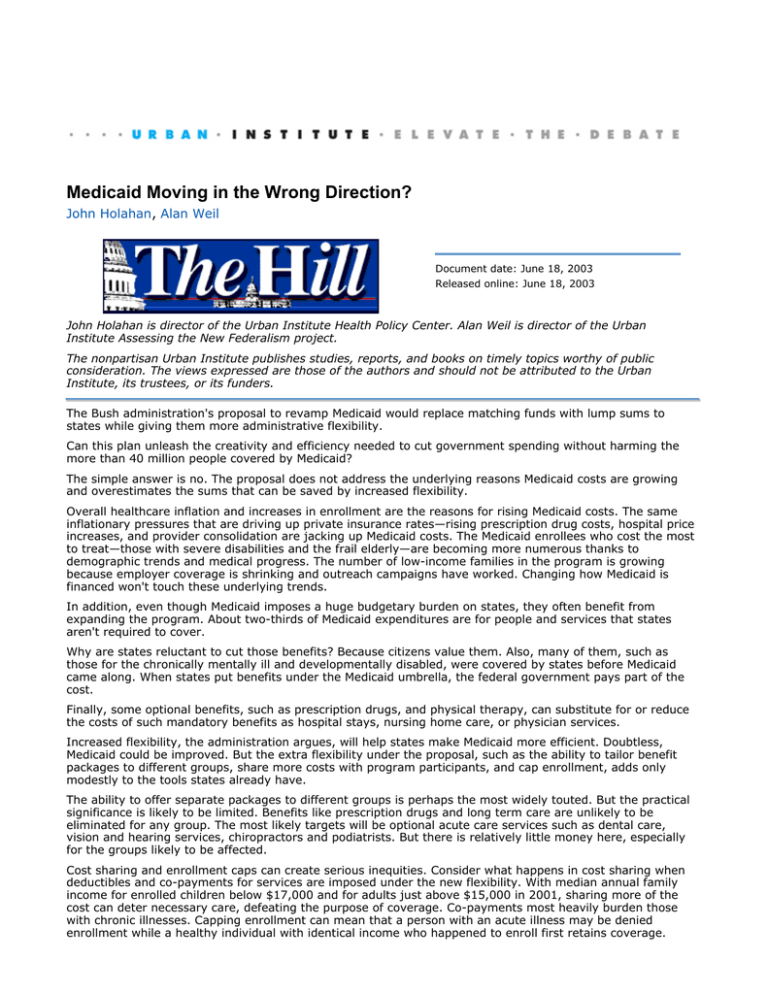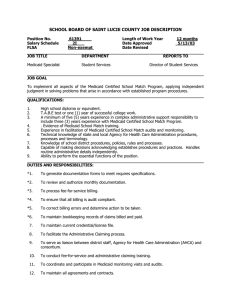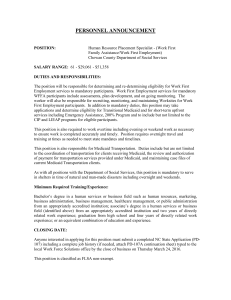Medicaid Moving in the Wrong Direction? John Holahan Alan Weil ,
advertisement

Medicaid Moving in the Wrong Direction? John Holahan, Alan Weil Document date: June 18, 2003 Released online: June 18, 2003 John Holahan is director of the Urban Institute Health Policy Center. Alan Weil is director of the Urban Institute Assessing the New Federalism project. The nonpartisan Urban Institute publishes studies, reports, and books on timely topics worthy of public consideration. The views expressed are those of the authors and should not be attributed to the Urban Institute, its trustees, or its funders. The Bush administration's proposal to revamp Medicaid would replace matching funds with lump sums to states while giving them more administrative flexibility. Can this plan unleash the creativity and efficiency needed to cut government spending without harming the more than 40 million people covered by Medicaid? The simple answer is no. The proposal does not address the underlying reasons Medicaid costs are growing and overestimates the sums that can be saved by increased flexibility. Overall healthcare inflation and increases in enrollment are the reasons for rising Medicaid costs. The same inflationary pressures that are driving up private insurance rates—rising prescription drug costs, hospital price increases, and provider consolidation are jacking up Medicaid costs. The Medicaid enrollees who cost the most to treat—those with severe disabilities and the frail elderly—are becoming more numerous thanks to demographic trends and medical progress. The number of low-income families in the program is growing because employer coverage is shrinking and outreach campaigns have worked. Changing how Medicaid is financed won't touch these underlying trends. In addition, even though Medicaid imposes a huge budgetary burden on states, they often benefit from expanding the program. About two-thirds of Medicaid expenditures are for people and services that states aren't required to cover. Why are states reluctant to cut those benefits? Because citizens value them. Also, many of them, such as those for the chronically mentally ill and developmentally disabled, were covered by states before Medicaid came along. When states put benefits under the Medicaid umbrella, the federal government pays part of the cost. Finally, some optional benefits, such as prescription drugs, and physical therapy, can substitute for or reduce the costs of such mandatory benefits as hospital stays, nursing home care, or physician services. Increased flexibility, the administration argues, will help states make Medicaid more efficient. Doubtless, Medicaid could be improved. But the extra flexibility under the proposal, such as the ability to tailor benefit packages to different groups, share more costs with program participants, and cap enrollment, adds only modestly to the tools states already have. The ability to offer separate packages to different groups is perhaps the most widely touted. But the practical significance is likely to be limited. Benefits like prescription drugs and long term care are unlikely to be eliminated for any group. The most likely targets will be optional acute care services such as dental care, vision and hearing services, chiropractors and podiatrists. But there is relatively little money here, especially for the groups likely to be affected. Cost sharing and enrollment caps can create serious inequities. Consider what happens in cost sharing when deductibles and co-payments for services are imposed under the new flexibility. With median annual family income for enrolled children below $17,000 and for adults just above $15,000 in 2001, sharing more of the cost can deter necessary care, defeating the purpose of coverage. Co-payments most heavily burden those with chronic illnesses. Capping enrollment can mean that a person with an acute illness may be denied enrollment while a healthy individual with identical income who happened to enroll first retains coverage. The block grant approach that's the bedrock of the Bush proposal raises broader concerns too. First, since states have to balance their budgets and can't run a temporary deficit the way the federal government can, economic downturns mean that precisely when program funds are stretched tightest Medicaid enrollment will be highest. State revenue streams are more volatile than those of the federal government. Second, block grants give states incentives to scale back coverage. This bias is built in since states get to keep all savings from program reductions but must pay the full costs of expanding program eligibility or increasing already-low payments to health care providers. Third, the grants set troubling inequities in stone: High-income states typically offer more generous programs and get more federal money (even though their matching-funds rate is lower). Current differences in spending among high- and low-income states are hard to justify. Perpetuating them indefinitely is even less justifiable. Fundamentally, converting Medicaid into a block grant is not the answer to the problems Medicaid faces. It won't meet escalating health care costs with state revenues that are unlikely to equal health care inflation even if state budgets recover. Nor will it eliminate the inequities in coverage and fiscal games that have made the federal government leery of building upon the program even though it has successfully met the health care needs of tens of millions of Americans. Block grants do nothing to make healthcare delivery more cost-effective. That would require more ambitious changes that improve the entire health care system, not just Medicaid. Ironically, block grants will most likely reduce innovation rather than fostering it. Why? Block grants take away the primary tool states need to make changes: money. If meeting the health care needs of the poor and the sick is still a national priority, the federal government's role must remain larger than writing checks to states. Converting Medicaid into a block grant moves health policy in the wrong direction. Other Publications by the Authors John Holahan Alan Weil Usage and reprints: Most publications may be downloaded free of charge from the web site and may be used and copies made for research, academic, policy or other non-commercial purposes. Proper attribution is required. Posting UI research papers on other websites is permitted subject to prior approval from the Urban Institute—contact publicaffairs@urban.org. If you are unable to access or print the PDF document please contact us or call the Publications Office at (202) 261-5687. Disclaimer: The nonpartisan Urban Institute publishes studies, reports, and books on timely topics worthy of public consideration. The views expressed are those of the authors and should not be attributed to the Urban Institute, its trustees, or its funders. Copyright of the written materials contained within the Urban Institute website is owned or controlled by the Urban Institute. Source: The Urban Institute, © 2012 | http://www.urban.org







